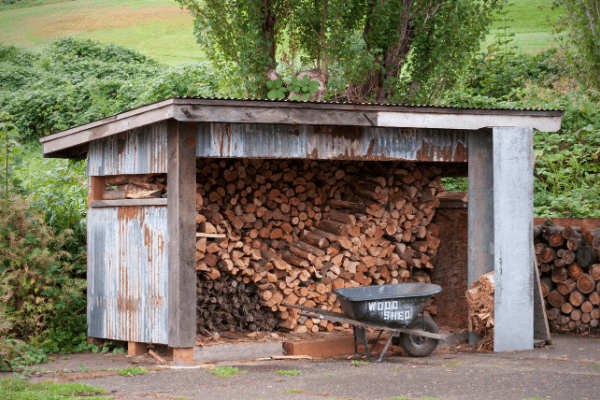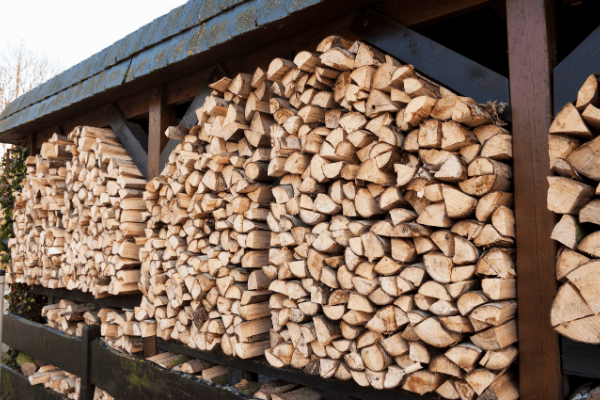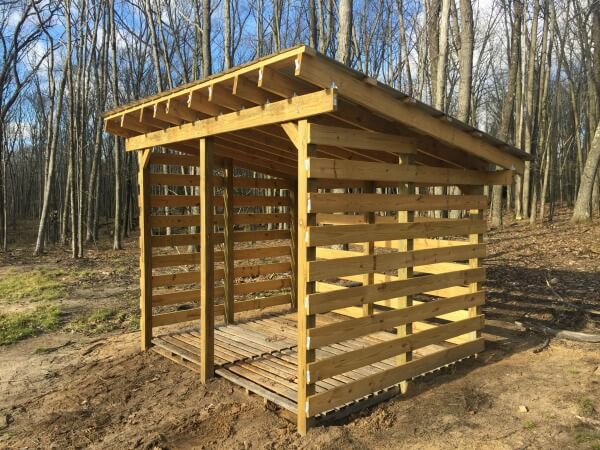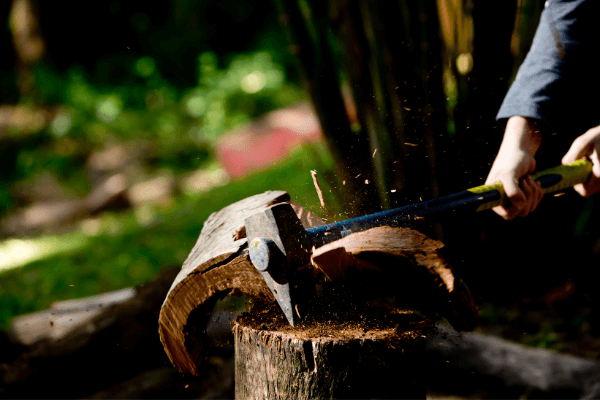- Home
- Storing Firewood
- Firewood Storage Shed
Firewood Storage Shed
This post may contain affiliate links so I earn a commission.
A firewood storage shed is a structure used to hold firewood and protect it from the weather, allowing it to season and stay dry.
Whether you bought your firewood or cut it yourself, protect your investment by storing your firewood in a shed or other shelter.
A storage shed can come in many different styles and sizes.
While the shed plans can vary in design, they should all have the same basic concept.
Generally constructed of a roof and three sides, a shed can protect your firewood and keep it ready for use.

Keeping your firewood off the ground will prevent moisture from soaking into the bottom row of wood.
It will also help prevent insects from contaminating your wood stack.
If your shed has a cement floor, it may not be necessary to stack it off the ground.
I have two lean-to structures on each side of my barn. One has a cement floor, and the other is dirt.
On the cement floor, I never place any kind of 2x4 runner down to prevent contact with the cement.
The dirt floor lean-to is different. I always stack the wood on a barrier.
What are the results?
I have never had a problem stacking my wood directly on the cement, and both lean-tos keep my wood dry and ready for use.
Old pallets also make a good ground barrier to stack your wood on.
They keep it away from the wet ground and allow air to flow under the wood, keeping it dry.
Use A Roof With Your Firewood Storage Shed
Having a roof over your shed will keep the rain and snow from ruining your supply of wood.
Constant rain and snow could reduce the quality of the top layers of your wood stack.
Just think, if you always grab firewood from the top layer and that layer is always getting rained on, then you're always grabbing wet wood!
If you have ever tried to start a fire with wet wood you know it can be very frustrating and time consuming.
A roof over the firewood is very convenient because it's permanent and unlike a tarp or cover, you never have to worry about taking it off and putting it back on.

The roof should be slanted to allow water to run off.
Have the roof overhang the woodpile on all sides to offer protection and prevent water from dripping on your firewood.
Sides On Your Firewood Storage Shed
Most firewood sheds have three sides and leave the front open for easy access and proper airflow.
It's important not to seal off the firewood on all sides because airflow is important to keeping the wood dry or allowing it to season.

The sides do not have to be constructed of a solid material.
Slatted sides with 2-4 inches between the pieces of wood will allow wind to penetrate the wood stack while still offering protection from the weather.
Qualities Of A Good Shed For Storing Firewood
- There is ventilation below the shed, and there are planks on all sides to allow for maximum breathability.
- Access to sunlight is important as it contributes to the proper seasoning of the firewood in the shed.
- The design of the woodshed should provide the ideal conditions for drying the interior of the wood.
- Apart from increasing the seasoning efficiency of firewood, your storage shed should complement your landscaping aesthetics.
Why You Need A Firewood Storage Shed
A firewood shed is designed to season your firewood.
That makes it, and keeps it ready to burn when you require it.
Drying your firewood is best done by keeping it covered with a shed roof while allowing air to flow around the woodpile.

This method of protecting and
covering your firewood from moisture while allowing air to flow through is
crucial to safeguard your investment in the logs while ensuring it is ready to
burn.
Choosing The Right Size Shed
Most firewood sheds are designed to be either 4 feet or 8 feet long to use construction materials economically and help keep track of the amount of firewood you have.
When choosing the firewood shed size, you should consider the amount of wood you will need during each burning season.
Storing Firewood In A Shed
Firewood seasoning is done by cutting, splitting, and storing your firewood.
Firewood takes about one year to season completely. Splitting firewood and storing it in a shed allows it to season quickly.
Proper firewood stacking is another crucial factor in allowing air to flow through it.
If your stack is too tight, then air will not flow well through it.
Also, if the stack is too loose, you will waste a lot of space inside your shed.
Try to stack your woodpile in uniform rows with wood pieces lying parallel to one another.
Throwing wood randomly into a spot wastes space inside the shed.
Cutting firewood into the right size is crucial so that the wood easily fits into your shed and fireplace when it is ready to burn.

Splitting your firewood is important to quicken
the seasoning process and to make it easier to stack.
Splitting firewood increases the surface area, which speeds up the drying process.
Airflow
Keeping air flowing around your woodpile is a very crucial part of firewood seasoning.
When there is insufficient airflow around your woodshed, the wood will keep moisture longer, promoting rot and mold.
A well-built firewood shed will keep snow and rain from landing directly on the wood.
Positioning Your Firewood Storage Shed
If firewood is the primary source of heat during the cold months, you will want to position your woodshed near your house.
If you use firewood occasionally, it is not important to keep your shed close to the house.
Because the front of a firewood shed is usually open, you should face it away from prevalent winds.
Overall
Storing your firewood in a shed is not something that you have to do, but it is convenient.
A firewood storage shed offers great protection and allows you to effectively store firewood for long periods of time without the risk of inclement weather damaging your firewood.
Look around...You will be surprised what you might find laying around to use a building material for a shed.
If you use a firewood storage shed, your firewood should stay dry and create a nice, warm, hassle-free fire.

About the Author
Obsessed with firewood, Nick is behind over 350+ of Firewood For Life's articles, as well as countless reviews, guides and YouTube videos to help readers like you reduce heating costs and create the perfect fire.


